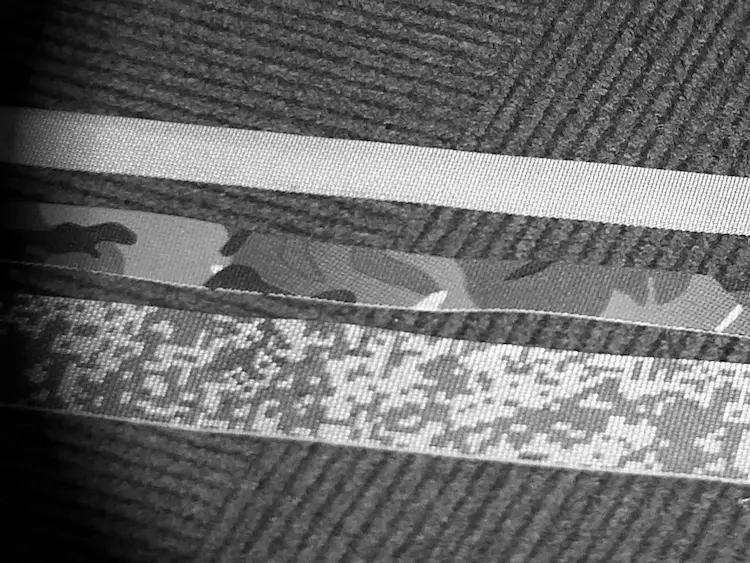In the world of tactical and military gear, every component matters. While fabrics and hardware get much of the attention, the unsung hero is the webbing. This network of high-strength straps is the backbone of modern load-bearing equipment, providing the strength and modularity essential for mission success. But not all webbing is created equal.
This guide delves into the specifics of military webbing, from the revolutionary MOLLE system to the critical importance of camouflage webbing and advanced IRR (Infrared Reflective) treatments.
Decoding the Technology: PALS, MOLLE, and Modularity
At the heart of modern tactical gear is the MOLLE (Modular Lightweight Load-carrying Equipment) system. Its foundation is PALS (Pouch Attachment Ladder System)—the grid of heavy-duty webbing sewn onto vests, backpacks, and belts. This simple yet brilliant design allows soldiers to customize their kits by attaching pouches and accessories exactly where they need them.
- Standardization: PALS webbing features rows of 1-inch webbing, spaced 1 inch apart, with bartacks every 1.5 inches. This strict standard ensures interoperability between gear from different manufacturers.
- Strength: This MOLLE webbing must be incredibly strong and abrasion-resistant to withstand the constant weight and friction of attached gear in harsh environments.
The Unseen Advantage: What is IRR Webbing?
In modern warfare, staying undetected is paramount, especially at night. Night Vision Goggles (NVGs) detect infrared (IR) light, which is invisible to the naked eye. Many standard dyes reflect IR light brightly, making soldiers and their gear stand out like a beacon to enemy NVGs.
IRR webbing, or Infrared Reflective webbing, is treated with special dyes and processes that reduce its infrared signature. This technology allows the webbing to absorb IR light and blend in with the natural environment when viewed through night vision devices. For any gear intended for serious military or law enforcement use, IRR compliance is not a feature—it's a necessity.
Beyond Green: The Science of Camouflage Webbing
Effective concealment requires more than just a single color. Camouflage webbing uses multi-colored patterns to break up the wearer's silhouette and help them blend into different terrains. Achieving this on a narrow strip of webbing is a technical challenge.
How Camouflage Patterns are Made:
- Piece-Dyed & Printed: A base color webbing (like Coyote Brown or Tan) is printed with the camouflage pattern. This is a common and effective method.
- Jacquard Weaving: For the highest-end solution, the pattern is woven directly into the fabric using different colored yarns. This results in a pattern that won't fade or scrape off and is double-sided.
Common patterns include MultiCam®, OCP, Woodland, and various digital or desert patterns, all requiring precise color matching to government specifications.
Material & Specifications: What Makes Webbing "Mil-Spec"?
To be used in official military equipment, webbing must meet stringent military specifications ("mil-spec"). These specs dictate everything from material composition and weave to tensile strength and colorfastness.
- Material: The most common material for military applications is high-tenacity Nylon webbing, prized for its exceptional strength, durability, and abrasion resistance.
- Berry Compliant: For U.S. Department of Defense contracts, all materials and labor must be 100% sourced and produced in the USA. This is known as the Berry Amendment. Sourcing Berry compliant webbing is crucial for manufacturers in this sector.
- Rigorous Testing: Mil-spec webbing undergoes extensive testing for tensile strength, UV degradation, colorfastness, and increasingly, IRR compliance.
Choosing the Right Partner for Your Tactical Gear Project
Creating world-class tactical gear requires a supply chain you can trust. The performance of your product depends directly on the quality of its components, and webbing is no exception.
As a specialized manufacturer, we understand the technical demands of the military and tactical industries. We work with our clients to produce custom military webbing solutions that meet exact specifications for pattern, color, width, and strength, including Berry compliant and IRR-treated options.
Whether you're developing the next generation of load-bearing vests or a line of rugged outdoor packs, the foundation matters. Contact TMG Webbing today to discuss your project and learn how our expertise can give you a competitive edge.

